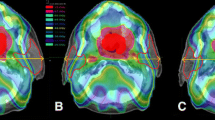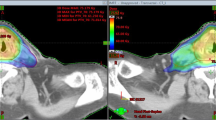Background and Purpose:
Intensity-modulated radiotherapy (IMRT) is used in most reported techniques for bilateral neck irradiation that aim at parotid gland sparing. A relatively simple conformal parotid-sparing technique (ConPas) was developed that uses no beam-intensity modulation. The purpose of this paper is to demonstrate, in patients with larynx or hypopharynx carcinoma, that ConPas enables adequate coverage of the primary tumor and the bilateral neck nodes, while keeping the mean parotid dose (MPD) < 26 Gy.
Patients and Methods:
Treatment plans using ConPas and the conventional technique (using one anteroposterior supraclavicular and two lateral beams) were computed for ten consecutive patients with T1–4 N0–1 larynx or hypopharynx carcinoma (not T1 glottic). A dose of 46 Gy was prescribed to the primary tumor and the bilateral neck nodes, planned either with the conventional technique or ConPas, followed by a boost up to 70 Gy with a simple two-field technique. The target coverage of both techniques was compared using the V95, the percentage of the planning target volume (PTV) of the primary tumor and nodal regions receiving at least 95% of the prescribed elective dose. The MPDs and the normal-tissue complication probabilities (NTCPs) of the parotid glands were compared using either technique including the boost up to 70 Gy. Dosimetric verification of the technique has been carried out, using ionization chamber measurements and film dosimetry.
Results:
The mean V95 was 85.2% and 91.2% (p = 0.08), the mean MPD 38.7 Gy and 25.4 Gy (p < 0.001), and the mean NTCP for the parotid glands 0.87 and 0.22 (p < 0.001) for the conventional technique and ConPas, respectively. The dosimetric verification shows a good agreement between dose calculation and measurement.
Conclusion:
ConPas enables adequate target coverage and clinically relevant parotid sparing in bilateral neck irradiation without beam-intensity modulation.
Hintergrund und Ziel:
Die intensitätsmodulierte Strahlentherapie (IMRT) ist die am häufigsten beschriebene Technik für bilaterale Halsbestrahlung mit Schonung der Parotis. Eine relativ einfache, die Parotis aussparende Technik (ConPas [„conformal parotid-sparing technique“]) wurde entwickelt, die keine Intensitätsmodulation benötigt. Ziel dieser Studie ist zu zeigen, dass bei Patienten mit Larynx- oder Hypopharynxkarzinom mit ConPas eine adäquate Dosisabdeckung des Primärtumors und der bilateralen Lymphknoten erreicht werden kann, wobei die gemittelte Dosis in der Parotis (MDP) < 26 Gy liegt.
Patienten und Methodik:
Für zehn konsekutive Patienten mit Larynx- und Hypopharynxkarzinom (T1–4 N0–1) wurde sowohl ein Bestrahlungsplan mit der ConPas-Technik als auch mit der konventionellen Technik (zwei seitliche Felder und ein anteroposteriores supraklavikuläres Feld) erstellt. Zuerst wurden die Patienten mit ConPas bzw. konventioneller Technik bis 46 Gy bestrahlt. Danach folgte ein Boost bis 70 Gy mit einfacher Zwei-Felder-Technik. Die Zielvolumenabdeckungen der beiden Techniken wurden mit Hilfe des V95 (Prozentsatz des Planungszielvolumens [PTV] des Primärtumors und der Lymphknotenregionen, der mindestens 95% der vorgeschriebenen elektiven Dosis erreicht) miteinander verglichen. Die MPD und die NTCP („normal-tissue complication probability“) der Parotiden wurden für beide Techniken verglichen. Dosimetrische Verifikationen wurden mit Ionisationskammer und Filmdosimetrie vorgenommen.
Ergebnisse:
Das gemittelte V95 lag für die konventionelle Technik bzw. ConPas bei 85,2% bzw. 91,2% (p = 0,08), die gemittelte MPD bei 38,7 Gy bzw. 25,4 Gy (p < 0,001) und die gemittelte NTCP für die Parotis bei 0,87 bzw. 0,22 (p < 0,001). Die dosimetrische Verifikation zeigt eine gute Übereinstimmung zwischen Dosisberechnung und Messungen.
Schlussfolgerung:
ConPas ermöglicht eine adäquate Zielvolumenabdeckung und eine klinisch relevante Parotisaussparung bei bilateraler Halsbestrahlung ohne Intensitätsmodulation.
Similar content being viewed by others
Author information
Authors and Affiliations
Corresponding author
Rights and permissions
About this article
Cite this article
Wiggenraad, R., Mast, M., van Santvoort, J. et al. ConPas: a 3-D Conformal Parotid Gland-Sparing Irradiation Technique for Bilateral Neck Treatment as an Alternative to IMRT. Strahlenther Onkol 181, 673–682 (2005). https://doi.org/10.1007/s00066-005-1413-8
Received:
Revised:
Issue Date:
DOI: https://doi.org/10.1007/s00066-005-1413-8




